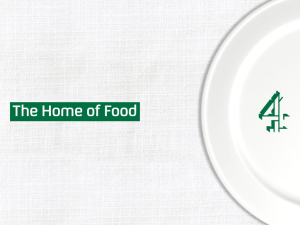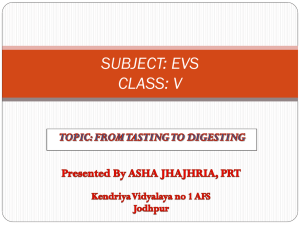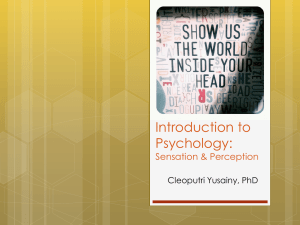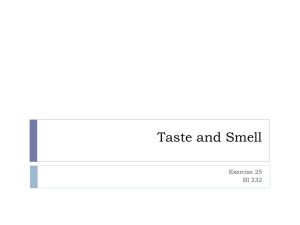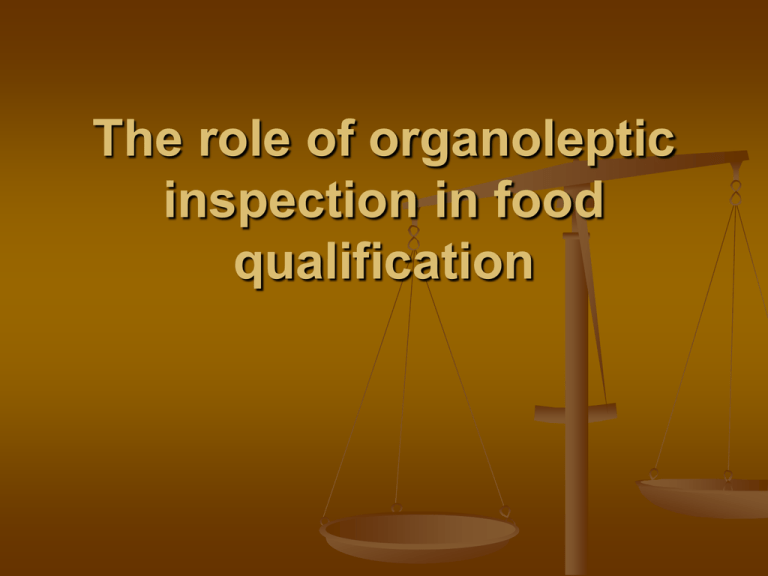
The role of organoleptic
inspection in food
qualification
Food quality components:
Food hygiene properties
Physical properties
Chemical properties
Packing and labelling
Organoleptic properties
Exterior characteristics: surface, colour, packing,
shape, form
Odour
Taste
Temperature
Substance and structure
Organs
eyes, nose, tongue and mouth, fingers, ears(!)
Using the human organs of senses as
measurement tools raises some problems:
the human organs of senses are liable to sensorial
errors
the human organs of senses are fatigable
there is a big biological variability
some bitter substances could be percepted only in higher
concentration by some people
some people are sensitive to the chumestrol-content of the
carrot
Sense of Taste
~6 million receptors on the tongue (dynamic balance),
with aging death>production of receptors → ~1,5-2
million
4 basic tastes (sweet, salty, sour, bitter), but there are
some more tastes:
taste generating pain sensation (capsaicine)
taste influencing the sensation of substance characteristics
(alkaline materials or contractive materials like alum)
metallic taste (FeSO4×7H2O)
the “umami” taste (complex taste, the taste of Na-glutamate; it’s
salty, sweet, bitter and metallic at the same time)
Haller’s taste catalogue contains 12 basic tastes (for
example there is taste generating changes in heat
perception – menthol)
Sweet taste
natural (sugars; mollenin – 2000 times sweeter
than sucrose; miraculum – changes the taste
effect: makes sweet from sour)
artificial (sugar-alcohols, ketones, esters, etc.) –
they were developed during the research of
diabetes
Intensity of the sweet taste increases with
water-solubility.
Making symmetric structure from an
asymmetric, the sweet taste changes into bitter
Sour, salty taste
Sour taste: acids
Depends from: acid concentration, pH, dissociation
rate, other food components, the buffer effect of
saliva
Intensity: acetic acid (the least intensive)→lactic
acid→malic acid→citric acid → tartaric acid (most
intensive)
Around the perception threshold
(0,02g/100cm3) the typical salty substances
(like NaCl) seem to be sweet, they appear to be
salty only around recognizing threshold
(0,08g/100cm3).
Salty taste: salt like materials
substance
taste
substance
taste
MgCl2
salty-bitter
K2SO4
sour-bitter
NH4Cl
salty-sour
BeSO4
sweet-sour
NaHCO3
salty-sweet
Pb-acetate
sweet (!)
MgSO4
bitter-sweet
Salts of heavy
metals
metallic
Bitter taste
Substances containing nitrogen, anorganic
salts, tanning materials, alkaloids
(caffeine, quinine, morphine, nicotine), etc
“Taste blindness”: some people (and
monkeys) don’t percept the bitter taste.
Factors influencing personal values
of taste sensing threshold
pH of the sample
temperature of the sample (no refrigeration temperature!)
clearness of the aroma substance
the water medium
size of the tongue surface
number of receptors on unit surface
Physical and psychical condition of the judge (judge has to know his
program 2 days before the inspection – no coffee, smoking, big
breakfast at the morning,etc.)
Circumstances of the inspection (noise, light, temperature, colour of
the wall, etc.)
part of the day (a.m. is the best – between 10-11 hours)
experience of the judge (Can be learned and improved by
practicing)
method of the inspection (drop-method, spoon-method, etc.)
other factors
Sense of Smell
Aroma: odour (in mouth) + odour (in nose) + taste
Scent: pleasant smell
Smell materials: common characteristics are: the –OH, –
CO, –COOH or –NH2 group
Factors influencing the sense of smell: temperature
(optimal: 25-30°C), part of the day (a.m.), age (20-40
years), sex of the judge (female), smoking (no),
experience (high)
Anomalies of the sense of smell:
hypozmia: decreased sense of smell
hyperozmia: hyper sensitivity (women)
anozmia: no sense of smell (above 80 years of age)
merozmia: no perception of specific smells
autozmia: sensation of smell without smelling substance
Textural characteristics
Rheological classification of food:
liquid
cell tissue structure (vegetables, fruits)
gel structure (cheese, jelly)
fibre structure (meat and meat products)
plastic (butter, margarine)
hard, fragile (cookies, chocolate)
complex (bread)
Choosing the judges: examination of
tasting-, smelling- and colour recognizing
abilities
Recognizing the tastes:
Sour: citric acid
Bitter: caffeine
Salty: NaCl
Sweet: sucrose
Umami: Na-glutamate
Metallic: FeSO4×7H2O
distilled water
methods:
draught method
spoon-test (more exact definition of amount)
drop-test (3 on the tongue – it’s the best; usually it turns to
ridicule
Recognizing the smells:
stable smell :ammonia
bitter almond smell: benzaldehide
sweat smell: butyric acid
Vinegar: acetic acid
nail polish smell: amyl-acetate
hospital smell: phenol
Vanilla: vanillin
butter aroma: Diacetile
Anise: anetole
method: put cotton-wool in a bottle, drop 0,5
cm3 of substance on it
Recognizing the colours
Ishikawa-test (ophthalmologic sight-test)
-10 bottle dilution series of 3 basic colours
(red, yellow, greenish-blue); should be put
in order
Faults in judgments:
perceptional: for example attractive packing
expectional: positive prejudice
habituation: too high number of samples, with
little differences
contrast: too big differences between samples
settle: the judge uses the middle values in
judging by points
tolerant approach: in case of favourite product
The perfect judge:
has to have normal organs of senses,
healthy, rested, with positive approach,
curious, compliant, teachable,
conscientious, capable, concentrated,
calm, well-balanced, free from prejudice,
critical, self-critical, reliable, disciplined,
accurate, self-confident, unimpressionable,
with good sense of phrasing, qualified
Methods of organoleptic
inspections
One test: the sample is compared with a standard sample. First
step: examination of the standard sample, then this standard is
removed. Second step: examination of samples (there are
standard samples and samples to be examined in the sample
series). The judges have to differentiate the samples from the
standard samples. Advantage: the sample series can be
examined however long. Disadvantage: the samples have to be
compared with a vision of memory.
Duo-trio test:
Tetrad test: 2 kinds of samples in 4 pots signed with codes. Aim:
which two are the same.
Two from five test: 5 pots: sample No1 is in 2 pots, No2 in 3 pots.
Pair test: there are 2 kinds of this test:
Differentiation of two samples: is there a difference between A and
B? (The “no difference” answer should be allowed.)
Indication of the direction of the difference (Which is more intensive?
Which is better?, etc.)
Descriptive organoleptic
inspections
The judgment should be made by an expert of
the specific sample/product. The sample is
compared with standards (Codex Alimentarius,
International standards, etc.).
There are two kinds of properties which should
be examined during the comparison:
positive characteristics, which should be present
disqualifying characteristics, which should not be
present
The presence/lack of positive and disqualifying
characteristics should be detailed in the result.
Decision: passed, not passed.
Methods for quantitative analysis
Extended examination of differences:
Description Scale
Grading: the samples are put in order on the
basis of a specific property, then a grade point
is given.
3) Judging by points:
a) 100 points, point subtraction scale
b) 5 points, weighting scale (or 20 points scale)
Every property can obtain 5 points, the different
importance of the properties is weighted with factors (the
factors’ sum has to be 4, so the sum of points
obtained will be 20).
Usually 4 properties are examined: appearance, odour,
taste and substance
Other methods
Matching together a concentration with sensation: for
example: comparing a sweetener (saccharin) with different
sugar-solutions. Result: which concentration of sugarsolution generated the same sweet taste perception as
saccharin?
Pouring method: for example: we pour clear water to
concentrated sugar-solution, and we try to find the
concentration which generates the same sweet taste
perception as saccharin. If it’s found → we measure the
sugar-solution’s concentration with refractometry → Result:
“The sweetener (saccharin) is as sweet as a …
concentration sugar-solution.”
Consumers’ judgements:
Popularity surveys
Scales:
scale of popularity
Observing the consumers
Examination of focus groups



